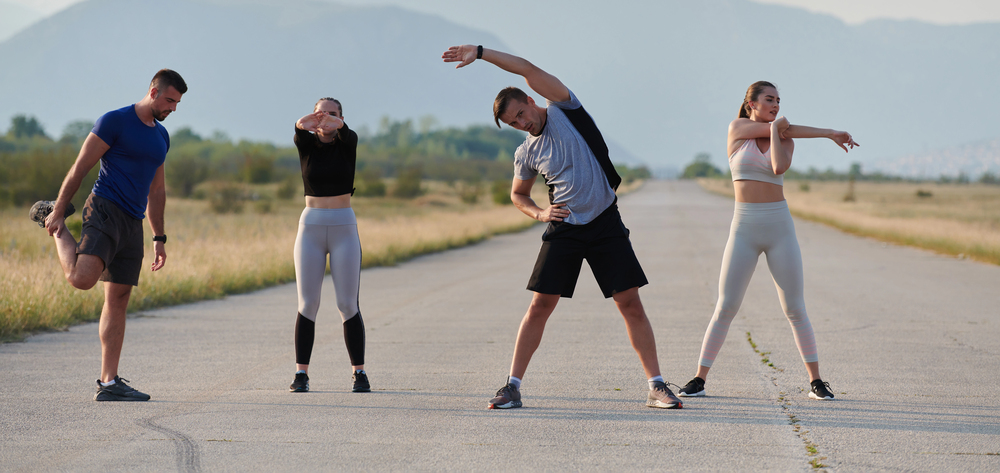Table of Contents
Toggle1. Understanding the Stretching Routine
A stretching routine is a structured set of movements designed to improve flexibility, mobility, and muscle function. It prepares the body for activity, enhances performance, and prevents injuries. A consistent routine promotes better blood flow and helps release muscle tension that builds up from exercise or daily activities. By regularly engaging in a Flexibility routine, you increase your body’s range of motion and support long-term physical health.
Stretching can be divided into two main categories: static stretching, where a position is held for a period, and dynamic stretching, which involves controlled movement through a range of motion. Both types play a crucial role in maintaining joint integrity and muscular balance.
2. Why Beginners Should Start With a Stretching Routine
For those new to fitness, a stretching routine is a gentle yet effective starting point. Beginners often experience tightness in key muscle groups due to sedentary habits, and a stretching routine helps reverse that. Starting slow allows muscles to adapt, reduces stiffness, and builds awareness of how the body moves.
A short stretching routine of 10–15 minutes daily can yield noticeable improvements in posture and comfort within weeks. Over time, flexibility gains reduce the risk of strains during workouts or daily chores. For beginners, consistency matters more than duration—stretching regularly keeps muscles supple and responsive.
3. Perfecting Your Stretching Routine Form
Proper form ensures your stretching routine is effective and safe. Move into each stretch gradually without bouncing or forcing the motion. Breathe deeply to help muscles relax. Avoid overstretching—pain signals that you’ve gone too far.
In a well-balanced mobility routing, include upper body stretches (shoulders, neck, arms) and lower body stretches (hamstrings, calves, quads). Always warm up first with light activity before stretching to prevent strain. Good posture and mindful breathing amplify the benefits and make your stretching routine more efficient.
4. Common Mistakes and How to Fix Them
Many people unknowingly undermine their stretching routine by making avoidable errors. Common mistakes include:
-
Skipping warm-ups: Cold muscles are more prone to injury.
-
Holding your breath: Oxygen flow is crucial for muscle relaxation.
-
Forcing flexibility: Pushing too far too soon leads to microtears.
-
Neglecting symmetry: Stretch both sides equally to prevent imbalance.
To correct these, start each stretching routine gently, maintain steady breathing, and progress gradually. Record your flexibility improvements to track results safely.
5. Stretching Routine Name Variations and Similar Exercises
The stretching routine is also known by several alternative terms: mobility sequence, flexibility circuit, dynamic warm-up, or post-workout stretch series. Each of these focuses on similar outcomes—improving muscle elasticity and joint movement.
Some related exercises include yoga flows, Pilates mobility drills, PNF (proprioceptive neuromuscular facilitation) stretching, and active stretching. These variations add depth to your flexibility work and help you avoid monotony.
6. Stretching Routine Variations to Keep It Fresh
To keep your stretching routine exciting, alternate between styles. For example:
-
Dynamic routine before workouts (leg swings, arm circles).
-
Static routine after workouts (hamstring or shoulder holds).
-
Yoga-based routine for relaxation and mindfulness.
-
PNF stretching with a partner for advanced flexibility gains.
Changing your routine prevents plateaus and engages different muscle fibers. Experiment with morning energizing stretches or evening relaxation flows to match your daily rhythm.
7. Benefits Beyond the Main Focus
A consistent flexibility routine offers more than flexibility. It enhances blood circulation, reduces stress, improves balance, and increases body awareness. Stretching also helps release endorphins, promoting a sense of well-being.
Research shows that an effective stretching routine can aid recovery by minimizing delayed-onset muscle soreness (DOMS). It also supports better coordination and posture, contributing to long-term joint health. For athletes, this means improved agility and reduced injury downtime.
8. How to Incorporate a Stretching Routine Into Your Routine
Incorporating a stretching routine into daily life doesn’t require much time. Add a quick 5-minute session in the morning to wake up your muscles and a 10-minute cool-down stretch after workouts. You can also stretch during breaks at work to relieve tension.
Use reminders or apps to schedule your stretching routine consistently. Pair stretching with music, breathing exercises, or meditation to enhance mental relaxation. By making it a ritual, your stretching routine becomes as natural as brushing your teeth.
9. The Science Behind the Stretching Routine
Scientific studies reveal that a regular stretching routine improves muscle elasticity by promoting collagen remodeling. It enhances joint lubrication and neuromuscular coordination. A balanced stretching routine supports proprioception—your body’s awareness of movement and position.
Stretching also influences the parasympathetic nervous system, helping reduce stress levels and lower heart rate post-exercise. Over time, this physiological balance contributes to overall health, reduced fatigue, and mental clarity.
10. Tracking Your Progress and Staying Motivated
Track your stretching routine results using a flexibility journal or fitness app. Note improvements in how far you can reach or how your posture changes over weeks. Celebrate milestones, such as touching your toes or achieving full splits.
Stay motivated by setting small, realistic goals and rotating your stretching routine styles. Join online stretching challenges or follow guided videos to maintain engagement. Over time, the consistency you build through your stretching routine will enhance both your physical and mental resilience.
Reference
Behm, D. G., & Chaouachi, A. (2011). A review of the acute effects of static and dynamic stretching on performance. European Journal of Applied Physiology. https://doi.org/10.1007/s00421-011-1879-2







